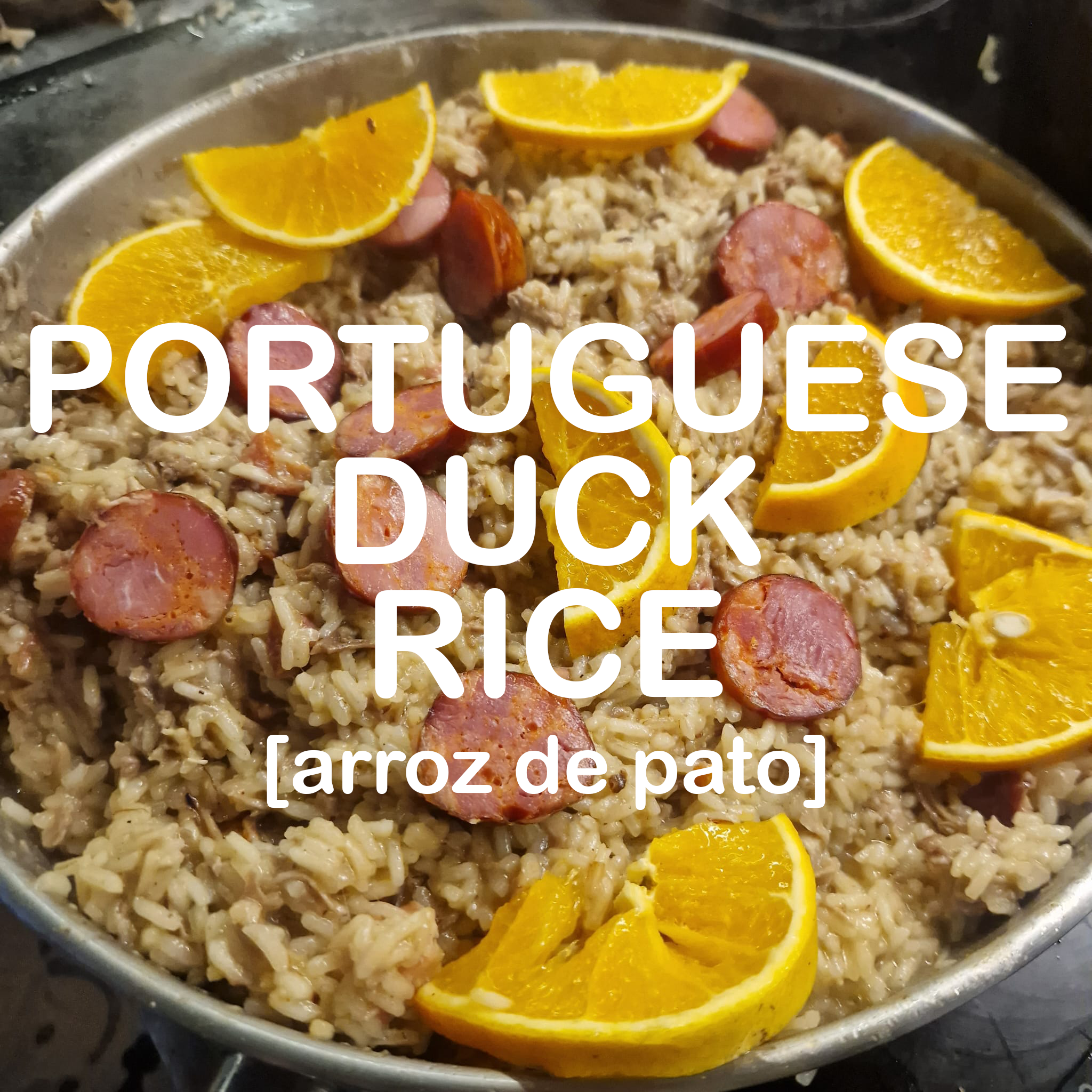
Sumptuous, gluttonous, addictive. Duck, chouriço, bacon, toasted rice. Lingering, warming spices. One of the finest pots in the Portuguese kitchen.
Arroz de pato is duck rice, a much-loved crowd-pleaser in Portugal that usually comes out at special occasions: family gatherings, birthdays, celebrations, etc. One of those dishes that involves buying and chopping up a whole bird, so people usually try and make it worth their time by inviting a bunch of people round to eat it with.
I need no such excuse to make arroz de pato. You can put this in the fridge and have duck rice for days. By yourself. That’s called a treat.
A delicacy from the North
Arroz de pato is supposedly from the north of Portugal, having a particular association with Braga, but other sources cite Alentejo and Moorish influences, which would make sense when you consider that common garnishes for this dish include fruits like oranges, which are popular in the South (and in the Alentejo in particular). As with lots of old-school Portuguese dishes, ingredients and techniques vary by region and household. The provenance remains uncertain, but the superiority of this dish as a crowd-pleaser is undisputed.
Rabbit stew in Portugal used to be done with wild rabbits only. Arroz de pato, another game dish, used to be done exclusively with wild ducks. Wild ducks can fly, making them less fatty and more tender, which I imagine to be a plus for this dish. But a whole duck from your butcher or even the supermarket isn’t going to be wildly different (pardon the pun), so I’d say the convenience trade-off is worth it on this occasion.
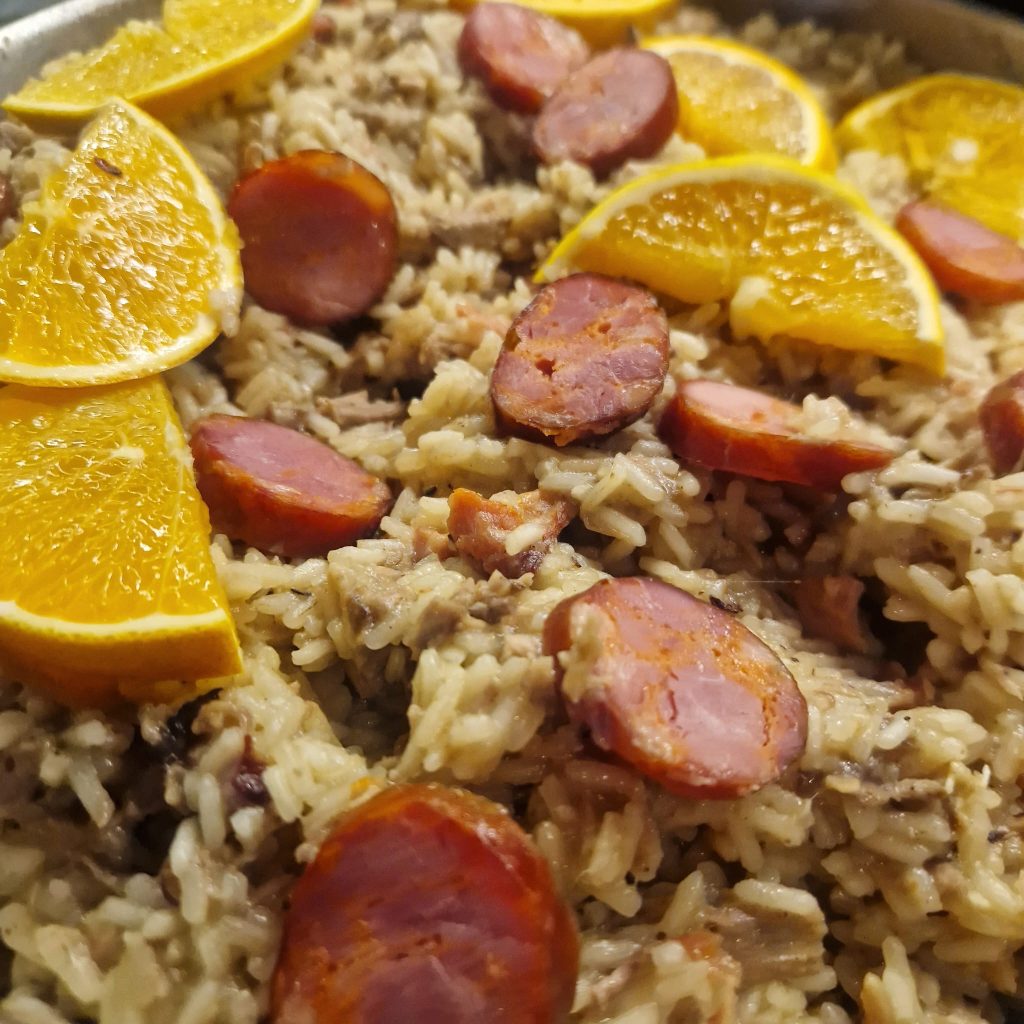
In Portugal, you can get duck in the supermarket that’s been pre-cooked, shredded and packaged to help facilitate the preparation of arroz de pato. There are two containers in the package – one with the shredded duck, and another with a serving of duck stock to cook your rice. Unlike most pre-made stocks that come in powder or bouillon form, this is proper liquid gold and it tastes very good.
This option reduces the amount of time you’ll spend making arroz de pato. But that’s the easy way. Not as fun.
This recipe is basically split into 3 main parts: roasting a whole duck in the oven for some mallard action, making a duck stock on the stove-top, then frying down a base of aromatics and enchidos to toast the rice with, which will then be simmered with the shredded duck and stock that’s been made.
A bit involved? Maybe. Worth it? Yes, yes, yes, yes…
Roasted birds
The first step, a tip from a Portuguese chef friend, is one that I’d never thought about doing with this dish. Before doing anything else, wash and gently pat dry the whole bird and begin breaking it down into its constituent parts.
You’ll want to break apart the duck much the same way as you would a whole chicken (this is less complicated than it sounds). It doesn’t have to be perfect, since the duck will be shredded later anyway.
Next, assemble the duck pieces on a baking tray and throw the tray into the oven at 200/220 °C (400-420 °F) for 20 minutes, with just a few pinches of coarse salt and nothing else.
The duck will cook in its own fat. It’s ready when it looks nicely browned (mallard reaction) and slightly roasted. If it doesn’t have these brown marks after 20 minutes, leave it in for another 5 or so minutes.
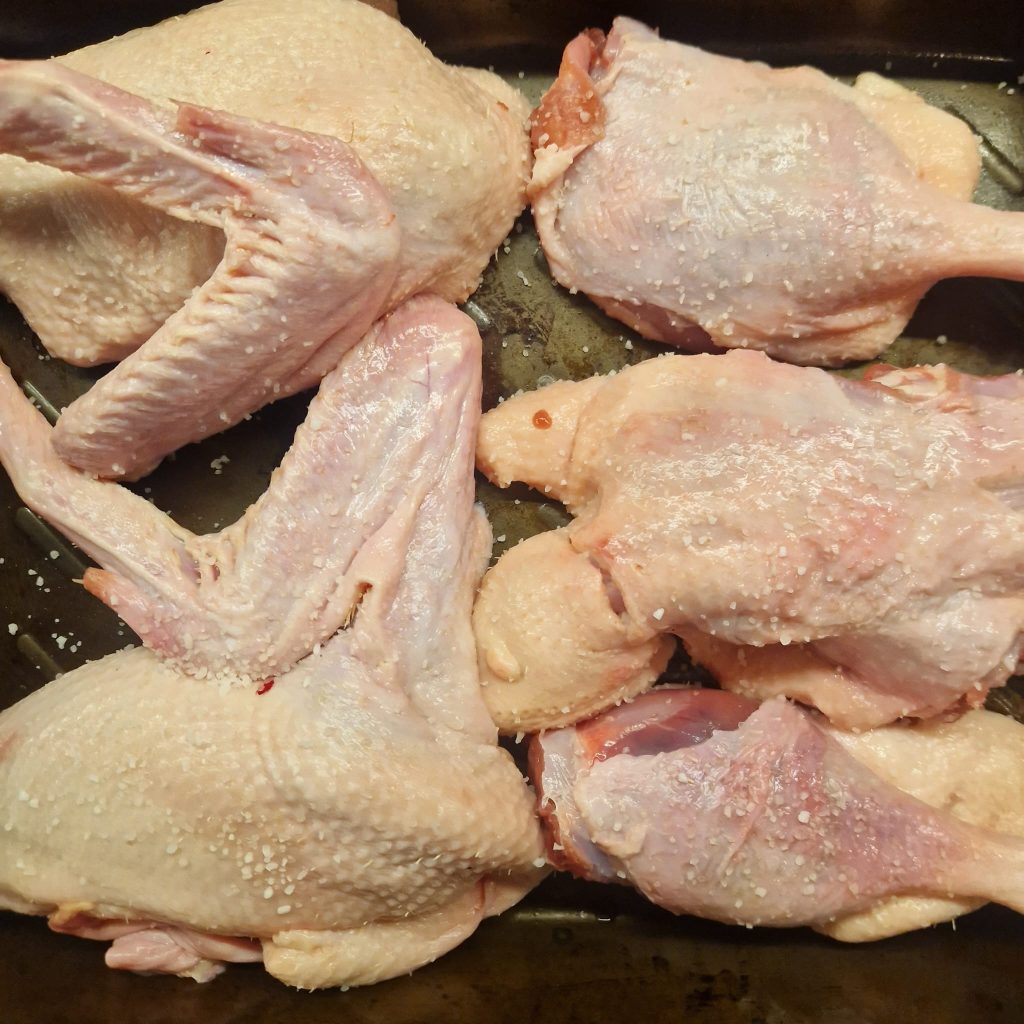
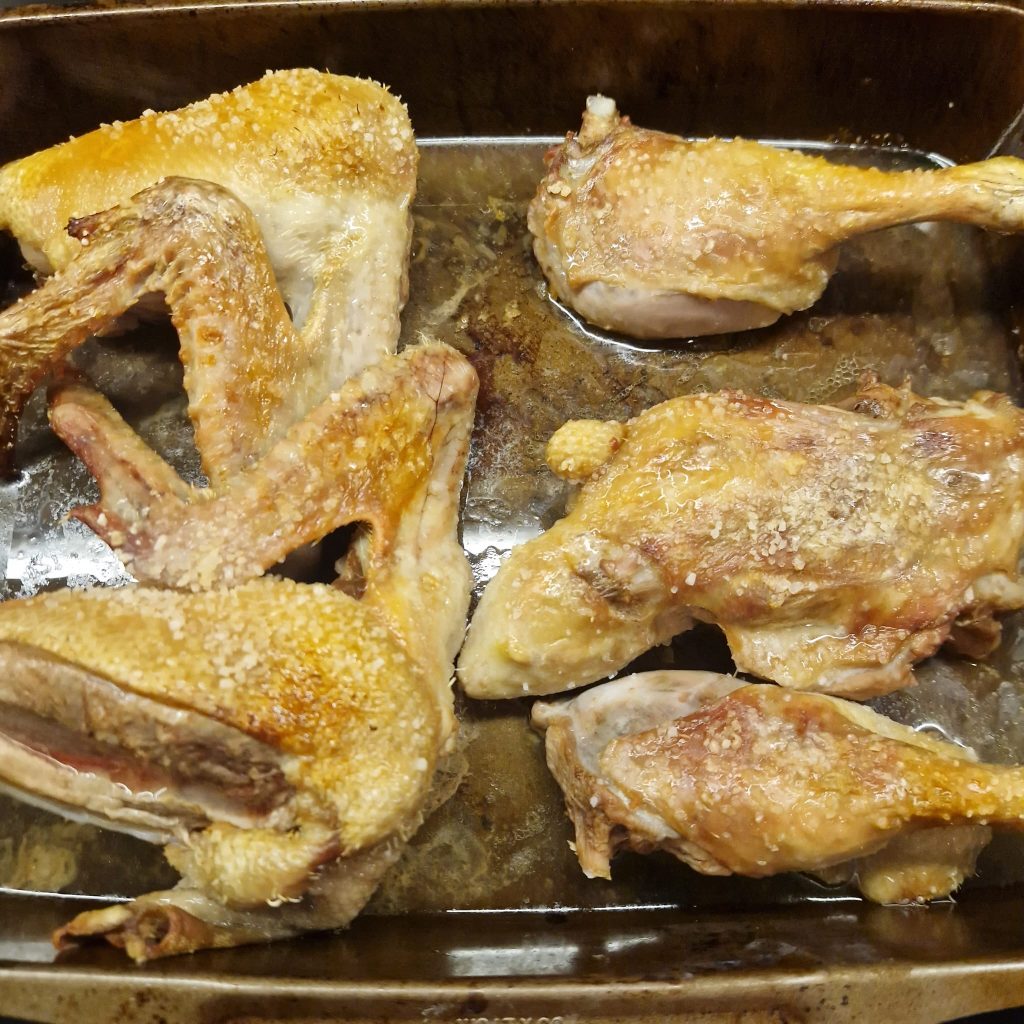
After this step, remove the duck from the oven, keep the rendered duck fat in the baking tray for later (liquid gold), let it cool and start assembling the stock.
Make a duck stock
For the stock, you’ll want to add the duck you’ve just roasted, bones included, to about 2.5 litres of water with a peeled and quartered onion, a good few peeled garlic cloves, a coarsely chopped carrot, half a teaspoon each of black peppercorns and cloves, 3 thin strips of orange peel (pith removed), herbs of choice (for me it was thyme), a couple of bay leaves, and your enchidos (in this case, half a chouriço, and a cut of touçinho, which is whole smoked-bacon). Plus a bit of salt, but not too much, since these enchidos are already on the salty side.
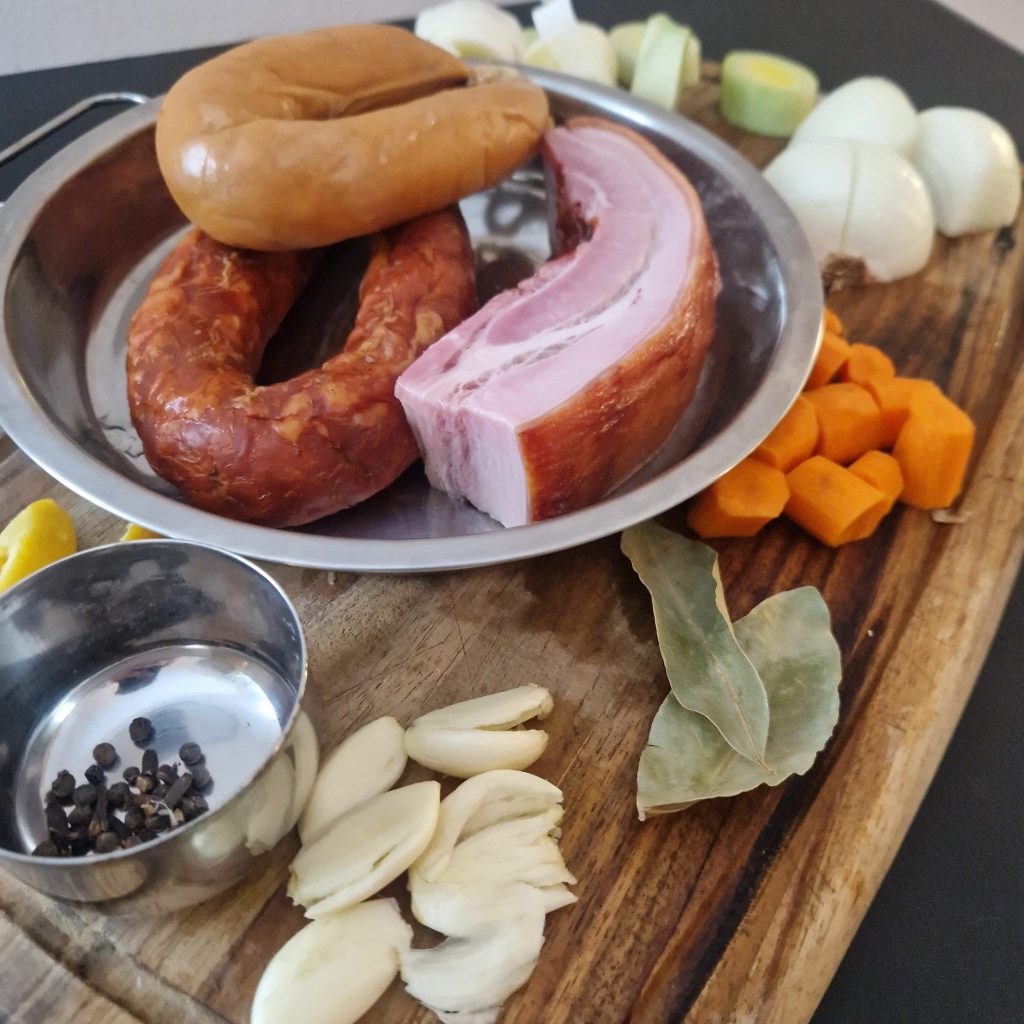
Leave this for around 40 mins uncovered at a low simmer. After 40 minutes, remove the duck, bacon and chouriço, shred the duck, dice the enchidos, strain the stock, and get together your ingredients for the final cooking step.
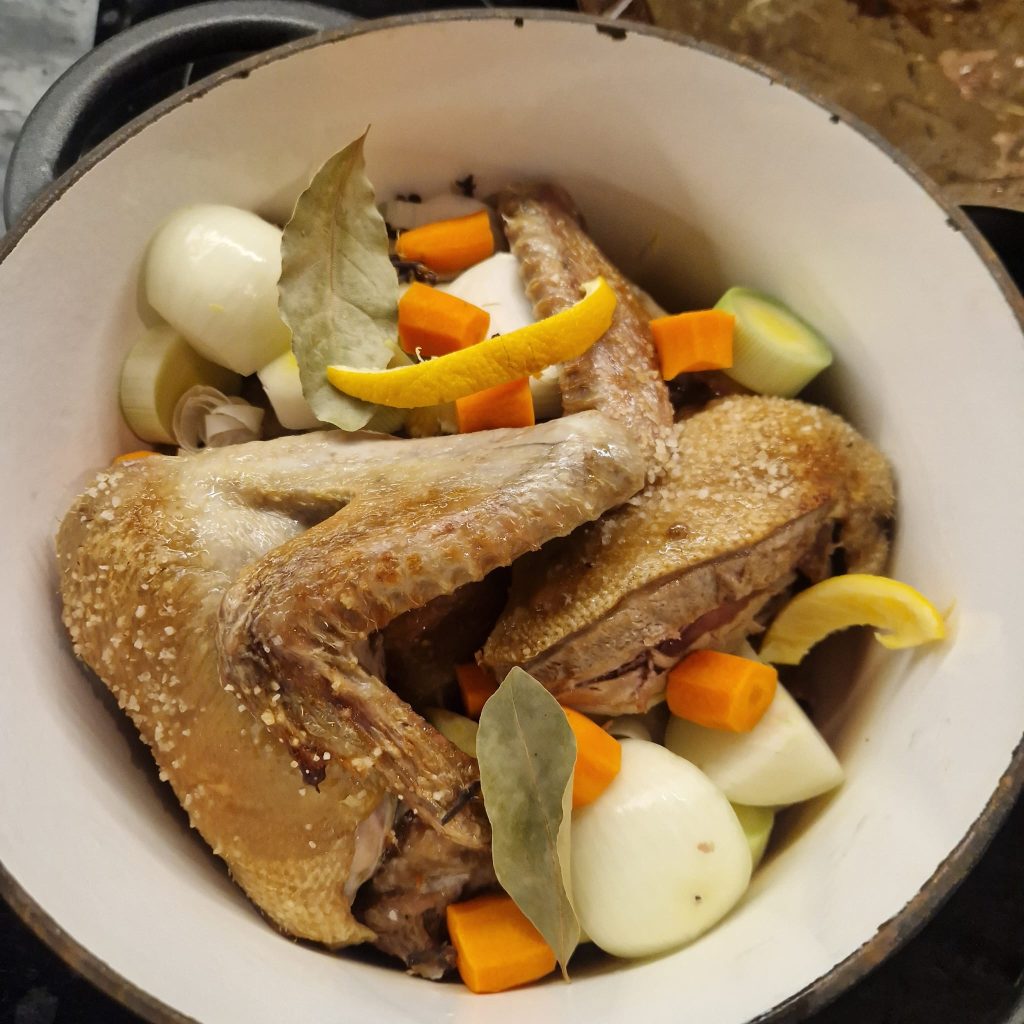
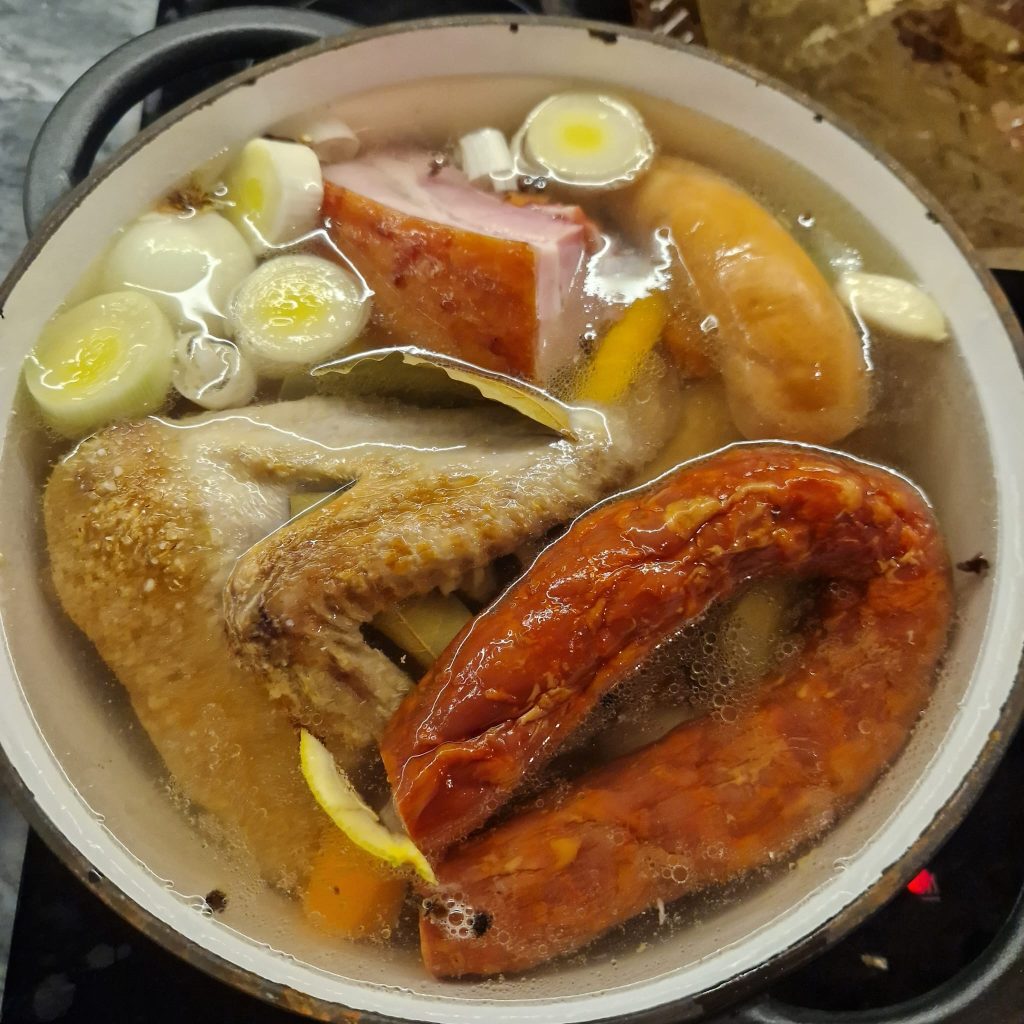
Pan-layered flavours
Once the stock is tasting good, and before cooking the rice, you start building up the flavours in the final pan. For this step, use a thick-set saucepan with enough height and diameter to accommodate all the contents of the dish, or maybe a dutch oven.
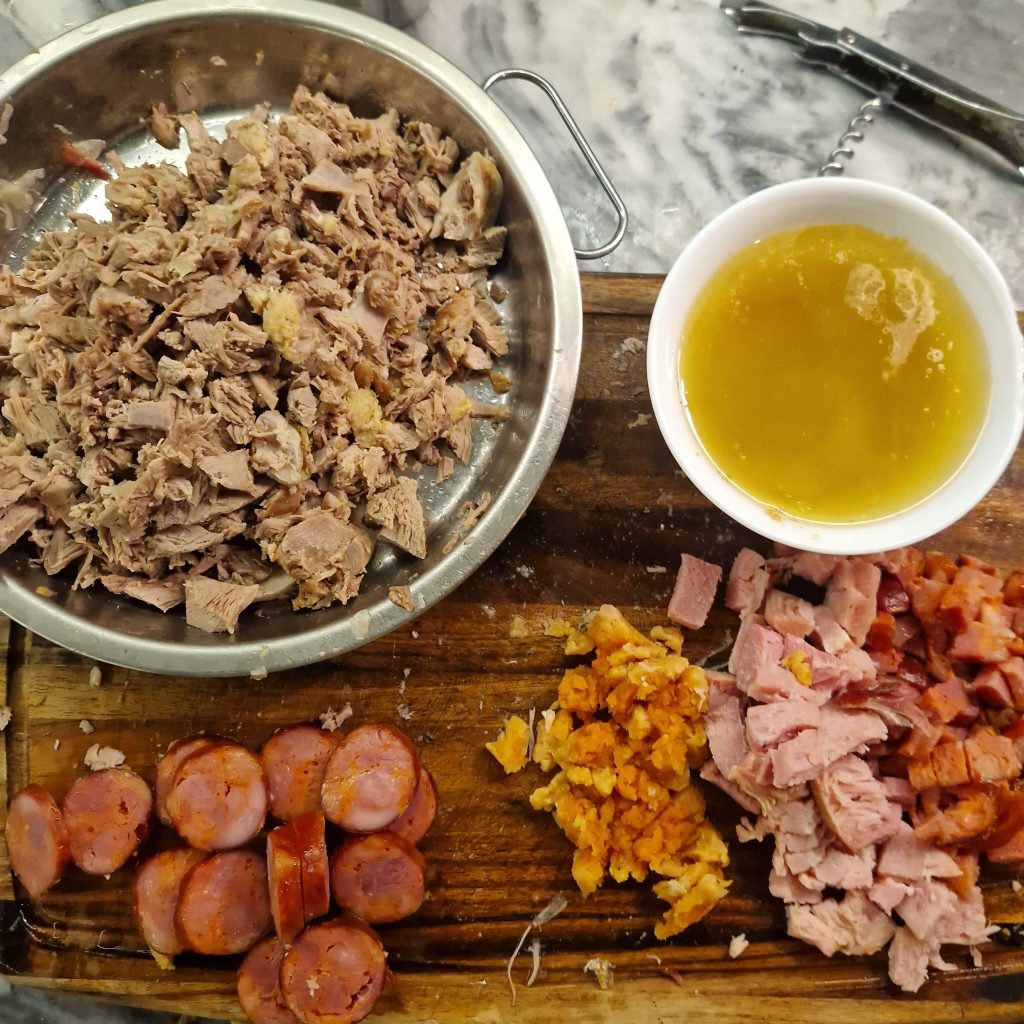
First in with the reserved duck fat and the diced enchidos – in this case, the chouriço and toucinho that had previously been cooked n the duck stock, plus diced farinheira, which is a kind of Portuguese wheat-flour and pork fat based sausage (I originally cooked the farinheira in the duck stock first, but I wouldn’t recommend it, as it started falling apart quite quickly – it’s better to just dice the farinheira ‘raw’ and fry it directly in the duck fat).
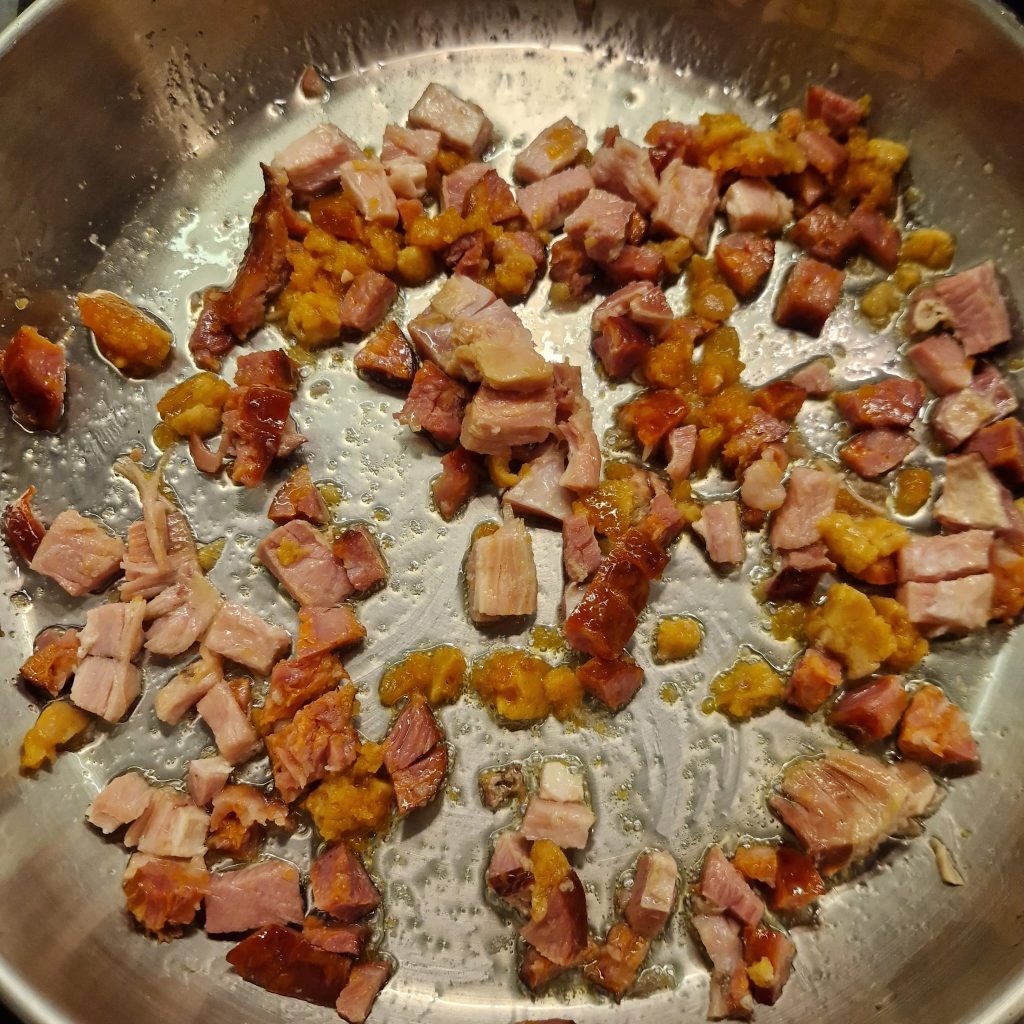
Next in with a diced onion, which you’ll want to push quite hard to the point of getting some caramelisation going on. By pushing hard, I mean at a low to medium heat, for a fairly long time – maybe around 10-12 minutes. Next, turn the heat to medium-high, throw in 2-3 cloves of diced garlic, sauté for two or three minutes, then it’s in with the rice, and onto a quite unconventional step.
Golden toasted rice
You’ll surely recognise that warm, golden hue that best-looking arroz de pato dishes have. This is due to the rice being toasted, either in the oven or directly in the pan, giving it a light crispiness and a final touch of flavour to top off the innumerable layers of flavour already working together in this dish.
A popular way to achieve this colour on the rice is to put the whole dish in the oven, uncovered, for 10-15 minutes after the rice has been cooked in the stock, but another tip from my chef friend was to actually toast the uncooked rice in the pan beforehand.
This sounds unconventional, but it solves a problem I’ve had with the oven method, namely that only the top layer of rice gets toasted in the oven.
Toasting the rice and pushing the heat while stirring pretty vigorously for 6-7 minutes gives the rice a completely even hue, endowing your rice with a gorgeous, all-round tan that many duck rices fail to achieve.

Ah, and it’s got to be arroz de agulha (long-grain rice). Carolina (or short-grain) clumps together too much, and vaporizado, or par-boiled, which I’ve used before for this dish, is apparently a sin. Arroz de agulha, especially when toasted in the pan, is the best form achieving a fluffy arroz solto, or loose rice, which is the ideal form for this dish.
Cook it down
Once you’ve got the desired colour on your rice, it’s time to simmer everything together and finish up the dish.
Add the shredded duck back to the toasted rice along with the strained duck stock you made earlier (enough to cover the rice plus half, aka a 1:1.5 ratio of rice to stock), and a few pinches of salt and pepper (but check for seasoning first). You can also add a bit of freshly squeezed orange at this point, if you want.

Leave this at a medium-low heat, covered if possible, for about 15-20 minutes, until the rice is almost tender while retaining a slight crisp, adding more stock if needed. After 15-20 minutes, leave the pot covered, off the heat, for a further 5 minutes.
Meanwhile, chop the other half of the chouriço into slices, cut some fresh slices of orange, and remove the lid from the pan. Take in that aroma, and top the pan with the chouriço and orange slices.
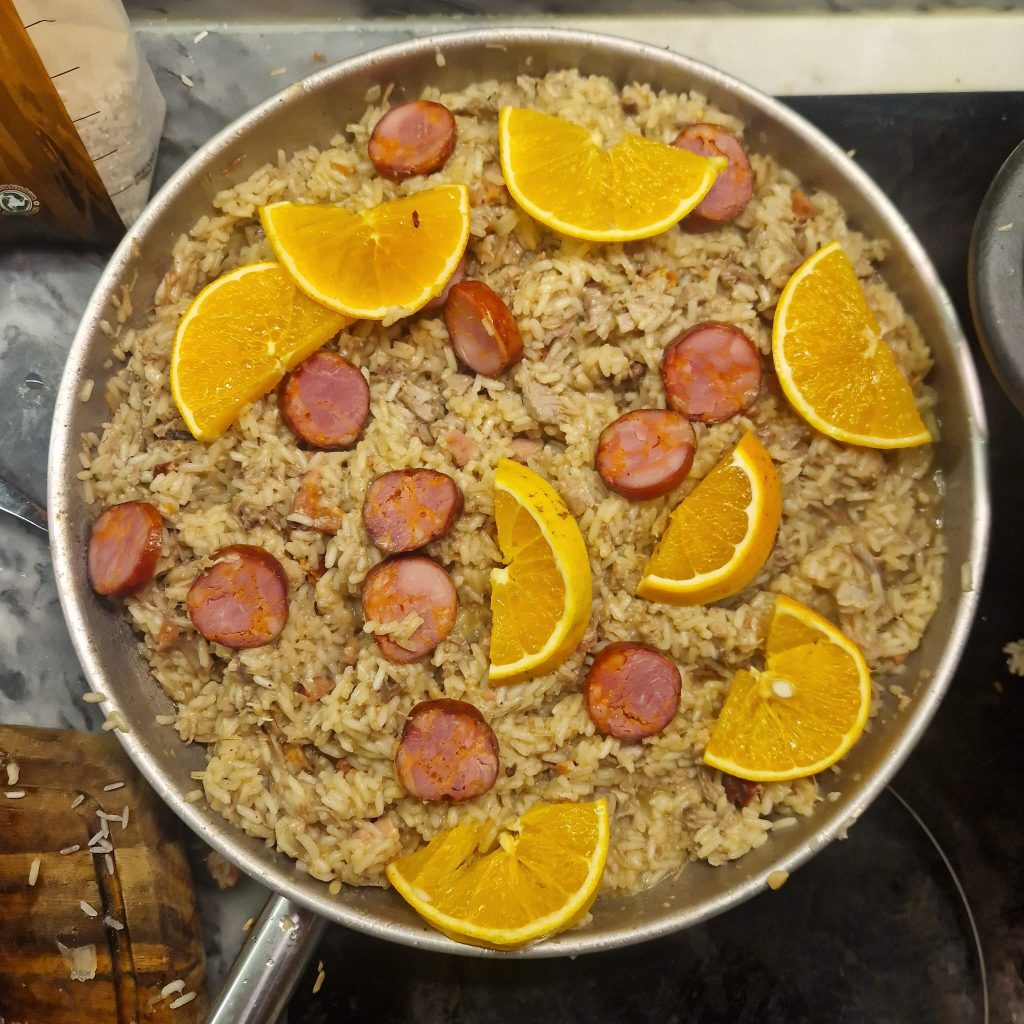
Serve individual portions with parsley or coriander, if you want.
Arroz de pato with serious layers of flavour. Your friends and family (or just your own lonesome soul) will thank you until the birds fall from the sky.

Arroz de Pato
Ingredients
The duck stock
- 1 duck whole
- 2.5 litres water
- 1 onion peeled and quartered
- 3 cloves garlic peeled and whole
- 1 sprig rosemary or thyme
- 1/2 tsp black peppercorns whole
- 1/2 tsp cloves whole
- 3 strips orange peel pith removed
- 2 bay leaves
- 1 carrot coarsely chopped
- 1/2 chouriço (chorizo) whole
- 100 g smoked bacon (touçinho fumado) whole
- 2 tbsp coarse salt
The rice
- 1 onion diced
- 5 cloves garlic diced
- 450 g arroz agulha or other long-grain rice
- The duck stock prepared earlier
- The duck fat prepared earlier
- 1 farinheira optional
- 1 orange sliced
- Coarse sea salt to taste
- Freshly-ground black pepper to taste
Instructions
Preparing the duck stock
- Break down the duck into its constituent pieces, removing excess skin, and roast the whole bird in a baking pan in the oven at 220°C (430°F), with a few pinches of coarse salt, until nicely browned – about 20 minutes (add 5 more minutes if the duck needs more browning). Duck fat will render in the baking pan – put it aside and save it for later.
- Once browned, remove the duck pieces from the baking pan and add it to a large saucepan with 2.5 litres of water and your aromatics: the quartered onion, the garlic cloves, carrot, bay leaf, herb sprigs (rosemary or thyme), spices (clove and black peppercorns) and orange peel, plus the whole chouriço and cut of toucinho (bacon). Add just a touch of sea salt and simmer on medium-low, uncovered, for 40 minutes.
- After around 40 minutes, remove the duck, chouriço and smoked bacon from the broth. Separate the duck meat from the bones, return the bones to the pot, and shred the duck with two forks. Finely dice the chouriço and smoked bacon, and set aside.
Cooking the rice
- Assemble the ingredients for the rice step: strain the stock, get the shredded duck and diced enchidos to hand, and finely dice the onion and garlic.
- In a large high-rimmed frying pan or dutch oven, add the duck fat and fry the enchidos (bacon, chouriço, and farinheira if you can find it) over a medium heat.
- Add the diced onion to the pan and caramelise well at a medium-low heat for 10-12 minutes. Add the diced garlic, cook for 2-3 minutes, and add the rice to the pan.
- Toast the uncooked rice in the pan at a medium-high heat for around 5-6 minutes, stirring constantly, raising and adjusting the heat where necessary so as not to burn or let the rice stick, until you achieve an even, golden-brown hue.
- Once the rice is toasted, add the shredded duck, the strained duck stock (at a rice/stock ratio of 1:1.5), a few squeezes of orange, and cook at a medium simmer, covered, for 15-20 minutes. Check for seasoning before simmering, and adjust as necessary.
- When the rice is almost tender, turn off the heat and let the pan rest with the lid on for a further 5-10 minutes.
- Serve individual portions with more sliced (uncooked) chouriço and orange slices, if desired.

Leave a Reply